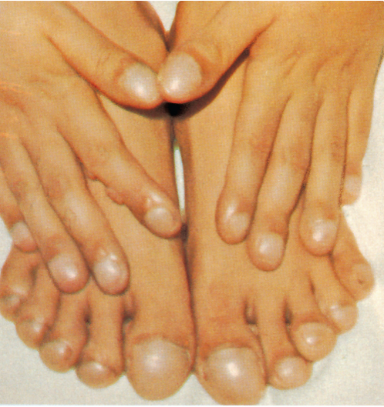Cyanosis
SYMPTOMS
What is cyanosis?
Cyanosis, also known as "cyanosis," refers to a deep bluish-purple color. The term "cyanosis" originally describes a dark blue hue with a purple tint.
It occurs when there is an increase in reduced hemoglobin (hemoglobin not carrying oxygen) or abnormal hemoglobin in the blood, causing the skin and mucous membranes to turn bluish-purple.
For example, the veins on the back of thin individuals appear bluish-purple, or when lips turn purple due to cold weather in winter.
Most cases result from hypoxia (hemoglobin not carrying enough oxygen before circulating), while a few are caused by structural abnormalities in hemoglobin.

Where does cyanosis usually occur?
Cyanosis often appears in thin, lightly pigmented, and highly vascularized skin and mucous membranes (easily visible areas like oral mucosa), such as the lips, nail beds (area covered by hard nails), tongue, nose tip, fingers, and earlobes.
How does cyanosis occur?
Blood color is determined by the state of hemoglobin:
- Normal oxygenated hemoglobin appears bright red;
- Deoxygenated hemoglobin appears bluish-purple;
- Abnormal hemoglobin may appear dark brown (methemoglobin) or bluish-brown (sulfhemoglobin).
When deoxygenated hemoglobin reaches a certain level (usually ≥50 g/L) or abnormal hemoglobin increases, blood in vessels turns bluish-purple, dark brown, or bluish-brown, causing the skin and mucous membranes to appear similarly.
Is there a pattern to cyanosis episodes?
Cyanosis episodes have no specific pattern, as different causes may lead to varying manifestations.
What is the connection between cyanosis and clubbing?
Clubbing refers to the widening and thickening of finger or toe tips, resembling drumsticks, often due to chronic hypoxia in the extremities. Long-term cyanosis patients frequently exhibit clubbing.

TREATMENT
How to relieve cyanosis?
- Excessive crying in infants and young children may also cause cyanosis around the lips. Calm the child's emotions, and the cyanosis will gradually subside after crying stops. If cyanosis persists or worsens after the child stops crying, aspiration or other conditions should be suspected, and medical attention should be sought promptly.
- Cyanosis in the hands, feet, or ears caused by sudden exposure to cold environments or factors like tension can be relieved by keeping warm or gently massaging the affected areas, and the cyanosis will gradually fade.
- Cyanosis occurring at high altitudes can be resolved by supplemental oxygen if available. Generally, when entering high-altitude areas or mines, oxygen supplies such as oxygen tanks should be prepared in advance.
- Cyanosis after intense exercise or exhaustion requires stopping or reducing physical activity, and the condition will gradually improve. Additionally, medical evaluation is necessary to identify the underlying cause and provide appropriate treatment.
Various diseases can cause cyanosis, with severity ranging from mild to severe and onset varying from gradual to sudden.
It is important to note: If the above measures fail to relieve cyanosis or if it worsens, seek medical attention immediately to determine the cause and receive appropriate treatment.
DIAGNOSIS
When should cyanosis prompt a hospital visit?
In most cases, cyanosis is noticed by others, though it can also be self-detected when occurring in extremities like limbs.
Generally, medical attention is advised whenever cyanosis appears to identify the cause and implement appropriate treatment. If severe cyanosis develops suddenly alongside hypoxia symptoms like chest tightness or breathlessness, it often indicates an urgent condition requiring immediate hospital care.
- If cyanosis occurs abruptly during eating/drinking (or in children due to choking on small toys), accompanied by suffocation, wheezing, or difficulty inhaling, it may signal airway obstruction by a foreign object. This is life-threatening—experienced individuals may perform the Heimlich maneuver immediately; otherwise, seek emergency care without delay.
- Cyanosis with chest pain or unconsciousness may result from pulmonary embolism or shock, typically in middle-aged/older adults. This is a critical situation demanding urgent hospitalization.
- Cyanosis present at birth or in early childhood suggests congenital heart disease, necessitating further medical evaluation.
- Seek prompt medical care if cyanosis follows consumption of spoiled vegetables or medications like sulfonamides/phenacetin.
POTENTIAL DISEASES
What are the possible causes of cyanosis?
Cyanosis may be associated with the following conditions:
- Decreased atmospheric pressure or reduced oxygen levels in the environment
- Travel to high-altitude areas
- Entering oxygen-deficient environments such as mines
- Respiratory tract obstruction
- Blockage of the throat, trachea, or bronchi due to aspiration of food, toys, etc.
- Lung diseases
- Pulmonary embolism, pulmonary edema, cor pulmonale, pneumothorax, SARS, etc.
- Heart diseases
- Heart failure, congenital heart disease, arrhythmia, etc.
- Shock
- Cardiogenic shock, septic shock, etc.
- Vascular disorders
- Varicose veins, thrombophlebitis, arteriovenous fistula, venous thrombosis, etc.
- Food, drug, or chemical poisoning
- Spoiled vegetables
- Sulfur-containing drugs or chemicals: sulfonamides, phenacetin, etc.
- Others
- Menstrual cycle-related cyanosis in women
- Familial methemoglobinemia